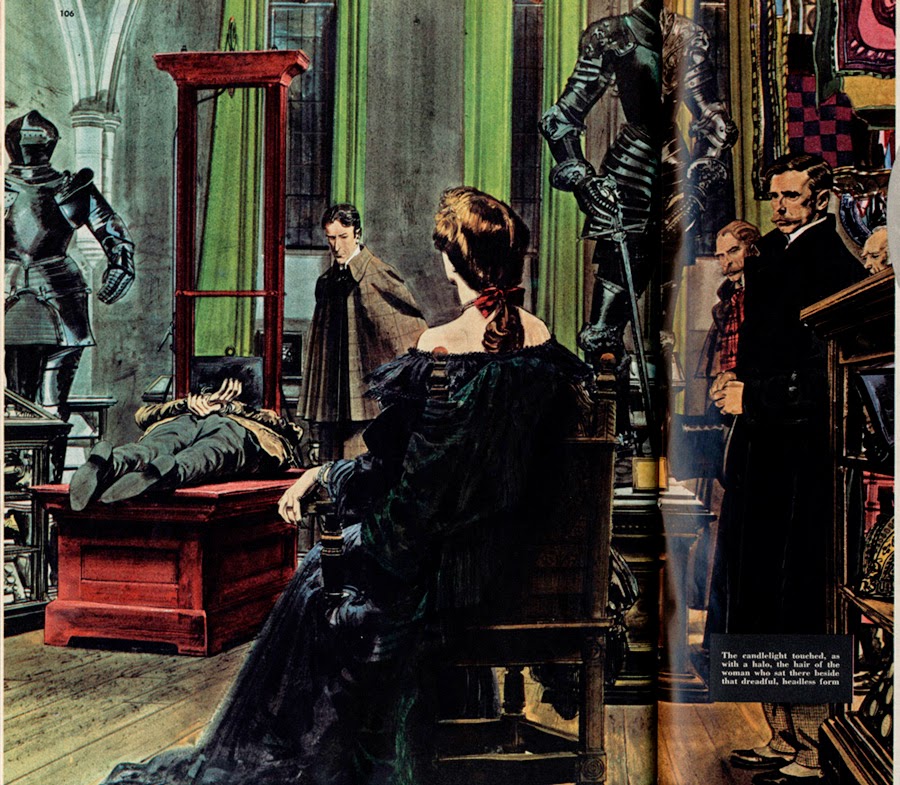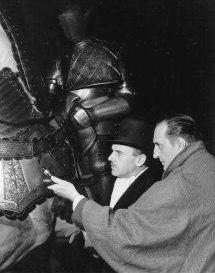|
|
Post by Jojo Lapin X on Mar 17, 2014 17:07:52 GMT
I have a Carter Dickson novel, Lord Of The Sorcerers, which has a particularly satisfying explanation that wouldn't work in a film but works in a book and probably would work in real life. I don't know why he sometimes used the pseudonym...is there a different remit for Carter Dickson as opposed to Dickson Carr? Broadly speaking, "John Dickson Carr" wrote about a character named "Dr Gideon Fell," while "Carter Dickson" wrote about "Sir Henry Merrivale." Carr wrote a lot, so it made sense to use different pen names in order not to compete with himself. The central device in the novel you mention is lifted from a Father Brown story by G K Chesterton. Carr is not the only one who has appropriated it; it has been quite popular. It does depend somewhat on a particular view of society and its various inhabitants, however. |
|
|
|
Post by thecoffinflies on Mar 17, 2014 23:03:24 GMT
That makes sense. I like Father Brown too, but haven't read 'em all. When I do I'll keep an eye out for that one...
|
|
|
|
Post by jamesdoig on Mar 18, 2014 5:03:58 GMT
Broadly speaking, "John Dickson Carr" wrote about a character named "Dr Gideon Fell," while "Carter Dickson" wrote about "Sir Henry Merrivale." The Merrivale mystery, The Plague Court Murders, is well worth a read - there's an excellent ghost story in it that's listed in The James Gang. |
|
|
|
Post by Jojo Lapin X on Mar 18, 2014 7:56:07 GMT
That makes sense. I like Father Brown too, but haven't read 'em all. When I do I'll keep an eye out for that one... If you have read any Father Brown stories, you have probably already read that one. It is one of the earliest, and probably the most anthologized one as well. |
|
|
|
Post by Craig Herbertson on Mar 18, 2014 23:13:41 GMT
That makes sense. I like Father Brown too, but haven't read 'em all. When I do I'll keep an eye out for that one... If you have read any Father Brown stories, you have probably already read that one. It is one of the earliest, and probably the most anthologized one as well. Don't think I've read any Carr stuff but coincidentally just ordered one/Looking forward to it. |
|
|
|
Post by Craig Herbertson on Mar 21, 2014 15:05:28 GMT
|
|
|
|
Post by Craig Herbertson on Mar 23, 2014 18:56:37 GMT
Nearly finished. Utterly bamboozled. Tried the Dem technique of suspecting everyone. Failed miserably so far to even guess who was actually murdered (never mind the murderer or the method) despite being told about fifty times. Think this would even appeal to hardcore horror fans as its quite macabre and an excellent read. |
|
|
|
Post by Craig Herbertson on Mar 24, 2014 7:27:51 GMT
The master of the 'Locked Room' mystery. I had quite forgotten about him, until I got stuck into the latest issue [288] of Fortean Times, where there is an article, complete with two great cover illustrations. I have only read a couple of his tales - 'The Case Of The Constant Suicides', and 'The Hollow Man' [great evocative titles, eh?], and remember enjoying their convolutedness [if that's not a word - sorry]. I would very much like to read some more. Anybody know if there are any volumes of his collected work available? Or is he sadly quite forgotten? He doesn't deserve to be.   Professor Charles Grimaud and his circle meet at a tavern. They are interrupted by a mysterious stranger who says that men can rise from their graves. The stranger, an illusionist called Pierre Fley, claims to have this rather natty ability, and couples this with the news that he has an even more dangerous brother who wants to kill Grimaud. He tells Grimaud to choose which of the two brothers he wants to pop round (him or the naughtier one), and Grimaud tells him to send his brother and be damned. It's this use of 'Tavern' and 'be damned' that gives the clue to the chatty anecdotal tone of the book. If you like the casual academics, smug doctors and amateur intellects that appear in in the likes of M.R. James you'll probably like the style. Anyway. a few nights later, the anticipated visitor arrives; he appears to have a false face. Now the fun begins. A witness sees Grimaud let the stranger into his study and close the door, and continues to observe the door until after a few minutes, shots ring out from the study. The locked door to the study is broken down and Grimaud is found dying from a gunshot wound. Naturally the murderer couldn't get out - but he did. I won't say anymore, as part of the appeal is a continuing chain of inexplicable things. These mysteries are mixed in with some wonderful eerie background, macabre situations and some genuinely horrific situations. The characters are all well drawn and mostly seem to be living on the edge of a nightmare, emotionally drained or over vitalized and, although larger than life, perfectly in balance with the series of events. I have to say Carr is master writer. I actually sussed out one thing about the murder (and that was by the 'fire every dart at the target and hope' method) but compared to the average mortal Carr has the brain the size of several multiverses. Even a hardcore horror fan who wouldn't read a crime novel if it was the last book on the desert island would like this as is its just so seamlessly written, puzzle following on puzzle, totally logical but utterly baffling and there is a consistently surreal and macabre element operating in the background which maintains a kind of horrific ambience. |
|
|
|
Post by pulphack on Mar 25, 2014 6:51:27 GMT
Carr was an exceptional plotter with an ingenious knack for the locked room - even if he did sometimes lift a few things, as mentioned - and was also a very good writer of characters. I have seen him denigrated by fools like Julian Symons (whose own work never really edged above the 'humdrums' he despised so much but who are the meat and drink of most crime and thriller readers because of their consistency)as one-dimensional, but whatever. I prefer him as Carter Dickson simply because I prefer Merrivale to Fell (who is very like Father Brown in some ways, which I suppose explains the Chesterton lift). But he's always worth a read. He also penned a Sherlock Holmes volume of shorts based on notes and references to cases in Doyle's papers and Holmes stories. These were co-credited to Adrian Conan Doyle, but were all Carr's work. Brian Doyle (no relation)- a writer on kids literature and film publicist - met Adrian and classed him as a foppish playboy who, like his brother, lived off their father's work and money and actually had no interest in writing or books at all (the brother, to be fair, kept a very close eye on the movie versions and was partly responsible for the magic Rathbone formula). Briefly - odd coincidences: Brian Doyle worked also on the Billy Wilder 'Secret Life...' Holmes movie, and stood in as the corpse who also appears on the cover of the book; I knew Brian ten years before I realised I'd been at school with his son, and his daughter had dated my chum Nikki Sudden (who wanted to be Sexton Blake and Biggles when he wasn't being Johnny Thunders or Keef)... it can be a very small world.
|
|
|
|
Post by Craig Herbertson on Mar 25, 2014 11:26:05 GMT
Excellent summary. Just discovered Carr and I suspect it's a whole list of 'to reads'. Unfortunately the completist in me needs all those locked room mysteries
|
|
|
|
Post by pulphack on Mar 26, 2014 5:51:06 GMT
This got me doing that 'walking the dog and thinking' thing, and I take back that bit about Fell being like Father Brown as such - they had similar deductive methods, but if you read a description of Fell and then anything about Chesterton, it becomes a short leap to realising that Fell is actually modeled on GK - the corpulence, the wheezy manner, the walking stick, the pronouncements... all very Chesterton. Carr started writing when GK was still alive, and was a dedicated Anglophile after spending a short while in Paris, and I have no idea but do wonder if he ever met GK and this was what inspired Fell?
|
|
|
|
Post by Craig Herbertson on Mar 26, 2014 12:23:47 GMT
|
|
|
|
Post by pulphack on Mar 26, 2014 16:17:21 GMT
Ah, thanks Craig!
|
|
|
|
Post by andydecker on Mar 12, 2021 9:05:56 GMT
Speaking of Carr, here are some covers of translated editions. These paperbacks were done in the early nineties, without cuts and with illustrations if included. Also a nice afterword giving context. Castle Skull Death in Five Boxes
The Hollow Man The Mad Hatter Mystery
The imprint also did novels by Ellery Queen, S.S. van Dine, Josephine Tey, Charlotte MacLeod, Phoebe A. Taylor.
|
|
|
|
Post by Michael Connolly on Jan 15, 2022 13:54:52 GMT
Carr was an exceptional plotter with an ingenious knack for the locked room - even if he did sometimes lift a few things, as mentioned - and was also a very good writer of characters. I have seen him denigrated by fools like Julian Symons (whose own work never really edged above the 'humdrums' he despised so much but who are the meat and drink of most crime and thriller readers because of their consistency)as one-dimensional, but whatever. I prefer him as Carter Dickson simply because I prefer Merrivale to Fell (who is very like Father Brown in some ways, which I suppose explains the Chesterton lift). But he's always worth a read. He also penned a Sherlock Holmes volume of shorts based on notes and references to cases in Doyle's papers and Holmes stories. These were co-credited to Adrian Conan Doyle, but were all Carr's work. Brian Doyle (no relation)- a writer on kids literature and film publicist - met Adrian and classed him as a foppish playboy who, like his brother, lived off their father's work and money and actually had no interest in writing or books at all (the brother, to be fair, kept a very close eye on the movie versions and was partly responsible for the magic Rathbone formula). Briefly - odd coincidences: Brian Doyle worked also on the Billy Wilder 'Secret Life...' Holmes movie, and stood in as the corpse who also appears on the cover of the book; I knew Brian ten years before I realised I'd been at school with his son, and his daughter had dated my chum Nikki Sudden (who wanted to be Sexton Blake and Biggles when he wasn't being Johnny Thunders or Keef)... it can be a very small world. The Sherlock Holmes collection cited is The Exploits of Sherlock Holmes (John Murray, 1954). I remember the twelve stories in it as being as unmemorable as the cover:  The book has often been cited as Sherlock Holmes Exploited. You can make up your own mind. There have been many editions of the book. And see here: archive.org/details/TheExploitsOfSherlockHolmes/mode/2upMore memorable are Robert Fawcett's illustrations for the Collier's Magazine publication of the stories. The following is for "The Adventure of the Red Widow":  One of the other stories, "The Adventure of the Black Baronet" was televised as a 1953 episode of Suspense, with Basil Rathbone as Holmes:  |
|